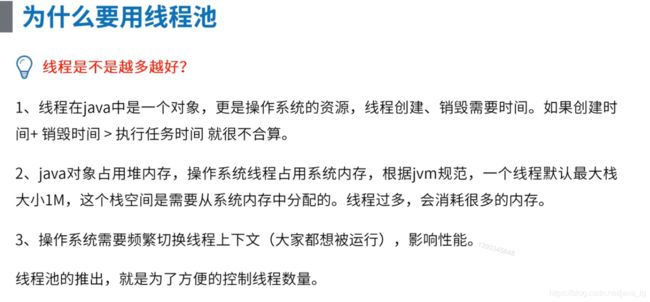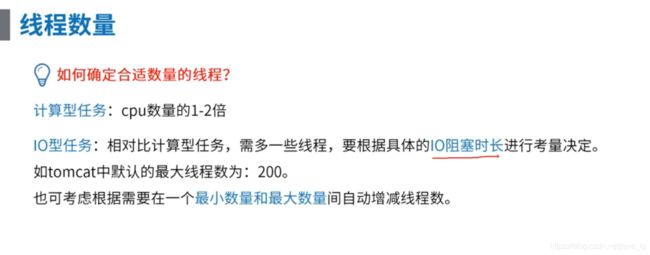线程池应用及实现原理剖析
线程池应用及实现原理剖析
1.线程池
1.1 为什么使用线程池
1.2线程池原理
1.3线程池相关API
1.4线程池API
方法定义(ExecutorService)

方法定义(ScheduledExecutorService)

Executors工具类

2.线程池原理 - 任务执行过程
import java.util.List;
import java.util.concurrent.*;
/** 线程池的使用 */
public class Demo7 {
/**
* 测试:提交15个执行时间需要3秒的任务,看线程池的状况
*
* @param threadPoolExecutor
* @throws Exception
*/
private void testCommon(ThreadPoolExecutor threadPoolExecutor) throws Exception {
// 测试:提交15个执行时间需要3秒的任务,看超过大小的2个,对应的处理情况
for (int i = 0; i < 15; i++) {
int n = i;
threadPoolExecutor.submit(
new Runnable() {
@Override
public void run() {
try {
System.out.println("开始执行:" + n);
Thread.sleep(3000L);
System.out.println("执行结束:" + n);
} catch (InterruptedException e) {
e.printStackTrace();
}
}
});
System.out.println("任务提交成功:" + i);
}
// 查看线程数量,查看队列等待数量
Thread.sleep(500L);
System.out.println("当前线程池线程数量为:" + threadPoolExecutor.getPoolSize());
System.out.println("当前线程池等待的数量为" + threadPoolExecutor.getQueue().size());
// 等待15秒,查看线程数量和队列数量(理论上,会被超出核心线程数量的线程自动销毁)
Thread.sleep(15000L);
System.out.println("当前线程池线程数量为:" + threadPoolExecutor.getPoolSize());
System.out.println("当前线程池等待的数量为:" + threadPoolExecutor.getQueue().size());
}
/**
* 1、线程池信息:核心线程数量5,最大数量10,无界队列,超出核心线程数量的线程存活时间:5秒, 指定拒绝策略的
*
* @throws Exception
*/
private void threadPoolExecutorTest1() throws Exception {
ThreadPoolExecutor threadPoolExecutor =
new ThreadPoolExecutor(5, 10, 5, TimeUnit.SECONDS, new LinkedBlockingDeque());
testCommon(threadPoolExecutor);
// 预计结果:线程池线程数量为:5,超出数量的任务,其他的进入队列中等待被执行
}
/**
* 2、 线程池信息:核心线程数量5,最大数量10,队列大小3,超出核心线程数量的线程存活时间:5秒, 指定拒绝策略的
*
* @throws Exception
*/
private void threadPoolExecutorTest2() throws Exception {
// 创建一个 核心线程数量为5,最大数量为10,等待队列最大是3 的线程池,也就是最大容纳13个任务。
// 默认的策略是抛出RejectedExecutionException异常,java.util.concurrent.ThreadPoolExecutor.AbortPolicy
ThreadPoolExecutor threadPoolExecutor =
new ThreadPoolExecutor(
5,
10,
5,
TimeUnit.SECONDS,
new LinkedBlockingDeque(3),
new RejectedExecutionHandler() {
@Override
public void rejectedExecution(Runnable r, ThreadPoolExecutor executor) {
System.err.println("有任务被拒绝执行了");
}
});
testCommon(threadPoolExecutor);
// 预计结果:
// 1、 5个任务直接分配线程开始执行
// 2、 3个任务进入等待队列
// 3、 队列不够用,临时加开5个线程来执行任务(5秒没活干就销毁)
// 4、 队列和线程池都满了,剩下2个任务,没资源了,被拒绝执行。
// 5、 任务执行,5秒后,如果无任务可执行,销毁临时创建的5个线程
}
/**
* 3、 线程池信息:核心线程数量5,最大数量5,无界队列,超出核心线程数量的线程存活时间:5秒
*
* @throws Exception
*/
private void threadPoolExecutorTest3() throws Exception {
// 和Executors.newFixedThreadPool(int nThreads)一样的
ThreadPoolExecutor threadPoolExecutor =
new ThreadPoolExecutor(
5, 5, 0L, TimeUnit.MILLISECONDS, new LinkedBlockingQueue());
testCommon(threadPoolExecutor);
// 预计结:线程池线程数量为:5,超出数量的任务,其他的进入队列中等待被执行
}
/**
* 4、 线程池信息:核心线程数量0,最大数量Integer.MAX_VALUE,SynchronousQueue队列,超出核心线程数量的线程存活时间:60秒
*
* @throws Exception
*/
private void threadPoolExecutorTest4() throws Exception {
/**
* SynchronousQueue,实际上它不是一个真正的队列,因为它不会为队列中元素维护存储空间。与其他队列不同的是,它维护一组线程,这些线程在等待着把元素加入或移出队列。
* 在使用SynchronousQueue作为工作队列的前提下,客户端代码向线程池提交任务时, 而线程池中又没有空闲的线程能够从SynchronousQueue队列实例中取一个任务,
* 那么相应的offer方法调用就会失败(即任务没有被存入工作队列)。此时,ThreadPoolExecutor会新建一个新的工作者线程用于对这个入队列失败的任务进行处理
* (假设此时线程池的大小还未达到其最大线程池大小maximumPoolSize)。
*/
// 和Executors.newCachedThreadPool()一样的
ThreadPoolExecutor threadPoolExecutor =
new ThreadPoolExecutor(
0, Integer.MAX_VALUE, 60L, TimeUnit.SECONDS, new SynchronousQueue());
testCommon(threadPoolExecutor);
// 预计结果:
// 1、 线程池线程数量为:15,超出数量的任务,其他的进入队列中等待被执行
// 2、 所有任务执行结束,60秒后,如果无任务可执行,所有线程全部被销毁,池的大小恢复为0
Thread.sleep(60000L);
System.out.println("60秒后,再看线程池中的数量:" + threadPoolExecutor.getPoolSize());
}
/**
* 5、 定时执行线程池信息:3秒后执行,一次性任务,到点就执行
* 核心线程数量5,最大数量Integer.MAX_VALUE,DelayedWorkQueue延时队列,超出核心线程数量的线程存活时间:0秒
*
* @throws Exception
*/
private void threadPoolExecutorTest5() throws Exception {
// 和Executors.newScheduledThreadPool()一样的
ScheduledThreadPoolExecutor threadPoolExecutor = new ScheduledThreadPoolExecutor(5);
threadPoolExecutor.schedule(
new Runnable() {
@Override
public void run() {
System.out.println("任务被执行,现在时间:" + System.currentTimeMillis());
}
},
3000,
TimeUnit.MILLISECONDS);
System.out.println(
"定时任务,提交成功,时间是:"
+ System.currentTimeMillis()
+ ", 当前线程池中线程数量:"
+ threadPoolExecutor.getPoolSize());
// 预计结果:任务在3秒后被执行一次
}
/**
* 6、 定时执行线程池信息:线程固定数量5 ,
* 核心线程数量5,最大数量Integer.MAX_VALUE,DelayedWorkQueue延时队列,超出核心线程数量的线程存活时间:0秒
*
* @throws Exception
*/
private void threadPoolExecutorTest6() throws Exception {
ScheduledThreadPoolExecutor threadPoolExecutor = new ScheduledThreadPoolExecutor(5);
/**
* 周期性执行某一个任务,线程池提供了两种调度方式,这里单独演示一下。测试场景一样。测试场景:提交的任务需要3秒才能执行完毕。看两种不同调度方式的区别 效果1:
* 提交后,2秒后开始第一次执行,之后每间隔1秒,固定执行一次(如果发现上次执行还未完毕,则等待完毕,完毕后立刻执行)。
* 也就是说这个代码中是,3秒钟执行一次(计算方式:每次执行三秒,间隔时间1秒,执行结束后马上开始下一次执行,无需等待)
*/
threadPoolExecutor.scheduleAtFixedRate(
new Runnable() {
@Override
public void run() {
try {
Thread.sleep(3000L);
} catch (InterruptedException e) {
e.printStackTrace();
}
System.out.println("任务-1 被执行,现在时间:" + System.currentTimeMillis());
}
},
2000,
1000,
TimeUnit.MILLISECONDS);
/**
* 效果2:提交后,2秒后开始第一次执行,之后每间隔1秒,固定执行一次(如果发现上次执行还未完毕,则等待完毕,等上一次执行完毕后再开始计时,等待1秒)。
* 也就是说这个代码钟的效果看到的是:4秒执行一次。(计算方式:每次执行3秒,间隔时间1秒,执行完以后再等待1秒,所以是 3+1)
*/
threadPoolExecutor.scheduleWithFixedDelay(
new Runnable() {
@Override
public void run() {
try {
Thread.sleep(3000L);
} catch (InterruptedException e) {
e.printStackTrace();
}
System.out.println("任务-2 被执行,现在时间:" + System.currentTimeMillis());
}
},
2000,
1000,
TimeUnit.MILLISECONDS);
}
private ThreadPoolExecutor testShutdownCommon() {
// 创建一个 核心线程数量为5,最大数量为10,等待队列最大是3的线程池,也就是最大容纳13个任务。
// 默认的策略是抛出RejectedExecutionException异常,java.util.concurrent.ThreadPoolExecutor.AbortPolicy
ThreadPoolExecutor threadPoolExecutor =
new ThreadPoolExecutor(
5,
10,
5,
TimeUnit.SECONDS,
new LinkedBlockingQueue(3),
new RejectedExecutionHandler() {
@Override
public void rejectedExecution(Runnable r, ThreadPoolExecutor executor) {
System.err.println("有任务被拒绝执行了");
}
});
// 测试:提交15个执行时间需要3秒的任务,看超过大小的2个,对应的处理情况
for (int i = 0; i < 15; i++) {
int n = i;
threadPoolExecutor.submit(
new Runnable() {
@Override
public void run() {
try {
System.out.println("开始执行:" + n);
Thread.sleep(3000L);
System.err.println("执行结束:" + n);
} catch (InterruptedException e) {
System.out.println("异常:" + e.getMessage());
}
}
});
System.out.println("任务提交成功 :" + i);
}
return threadPoolExecutor;
}
/**
* 7、 终止线程:线程池信息:核心线程数量5,最大数量10,队列大小3,超出核心线程数量的线程存活时间:5秒, 指定拒绝策略的
*
* @throws Exception
*/
private void threadPoolExecutorTest7() throws Exception {
ThreadPoolExecutor threadPoolExecutor = testShutdownCommon();
// 1秒后终止线程池
Thread.sleep(1000L);
threadPoolExecutor.shutdown();
// 再次提交提示失败
threadPoolExecutor.submit(
new Runnable() {
@Override
public void run() {
System.out.println("追加一个任务");
}
});
// 结果分析
// 1、 10个任务被执行,3个任务进入队列等待,2个任务被拒绝执行
// 2、调用shutdown后,不接收新的任务,等待13任务执行结束
// 3、 追加的任务在线程池关闭后,无法再提交,会被拒绝执行
}
/**
* 8、 立刻终止线程:线程池信息:核心线程数量5,最大数量10,队列大小3,超出核心线程数量的线程存活时间:5秒, 指定拒绝策略的
*
* @throws Exception
*/
private void threadPoolExecutorTest8() throws Exception {
// 创建一个 核心线程数量为5,最大数量为10,等待队列最大是3 的线程池,也就是最大容纳13个任务。
// 默认的策略是抛出RejectedExecutionException异常,java.util.concurrent.ThreadPoolExecutor.AbortPolicy
ThreadPoolExecutor threadPoolExecutor = testShutdownCommon();
// 1秒后终止线程池
Thread.sleep(1000L);
List shutdownNow = threadPoolExecutor.shutdownNow();
// 再次提交提示失败
threadPoolExecutor.submit(
new Runnable() {
@Override
public void run() {
System.out.println("追加一个任务");
}
});
System.out.println("未结束的任务有:" + shutdownNow.size());
// 结果分析
// 1、 10个任务被执行,3个任务进入队列等待,2个任务被拒绝执行
// 2、调用shutdownnow后,队列中的3个线程不再执行,10个线程被终止
// 3、 追加的任务在线程池关闭后,无法再提交,会被拒绝执行
}
public static void main(String[] args) throws Exception {
Demo7 demo7 = new Demo7();
// demo7.threadPoolExecutorTest1();
// demo7.threadPoolExecutorTest2();
// demo7.threadPoolExecutorTest3();
// demo7.threadPoolExecutorTest4();
// demo7.threadPoolExecutorTest5();
// demo7.threadPoolExecutorTest6();
// demo7.threadPoolExecutorTest7();
demo7.threadPoolExecutorTest8();
}
}






